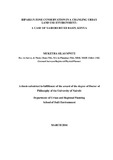| dc.description.abstract | Riparian zones are vegetated strips of land located on each side of a watercourse or
adjacent to a stationary water body. Ideally, the attributes of a riparian zone should include
among others uninterrupted continuum of vegetation cover, appropriate vegetation
structure and lateral width where ecological, social and economic functions should take
place.
However, despite their significance as urban landscape elements, riparian zones are facing
pollution, encroachment and degradation from urban land uses in Nairobi River Basin.
This is a result of improper determination, use and management. The implications of this
stated problem include failure to filter polluted surface run-off, riverbank erosion,
increased incidences of flooding and soil erosion, and death of aquatic and terrestrial
ecosystems that depend on riparian vegetation for survival. The cost of this problem to
Kenya as a nation is monumental.
The main objective of this study was to assess factors that affect the determination, use
and management of riparian zones in Nairobi River Basin. The study sought to answer the
question of whether the policy and institutional factors, land use and biophysical factors,
as well as, professional and land users’ factors influence conservation of riparian zones in
the basin. This was with a view of developing an integrated model of conservation of
riparian zones.
The study followed a descriptive research design which employed a mixed strategy
involving quantitative and qualitative methods. Secondary data was collected using
archival method. Primary data collection relied on questionnaires, observations and
scheduled interviews as the main methods. The technique of content analysis assisted in
grouping qualitative data thematically that was presented in a narrative form. Statistical
data were mainly analyzed using Statistical Package for Social Scientists (SPSS), and
summarized in percentages. The data was presented in tables and graphs to provide visual
relationships between variables. However, geographical information systems (GIS) spatial
techniques were used to examine the physical extent of the zones in relation to adjoining
land uses.
The study established that weak policy and institutional framework have led to haphazard
and incompatible multiple uses of the zones. In particular, planning and development
control mechanisms are weak and there are unclear land administration guidelines and
procedures to secure the riparian width and vegetation. Land use and biophysical factors
are also not taken into account when formulating and implementing policies while
professionals and land users have limited or no roles at all in securing riparian zones. As a
result, these factors have played a major role in the continued indiscriminate invasion and
ecological deterioration of riparian zones in the basin.
In conclusion, there is improper determination, use and management of riparian zones in
Nairobi River Basin. Therefore, the areas that physically and ecologically fall in these
riparian zones are encroached and degraded by urban land uses. The study recommends
among others, an integrated model for effective determination, use and management of
riparian zones. | en_US |

